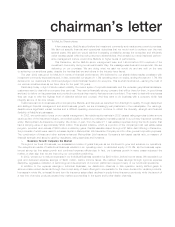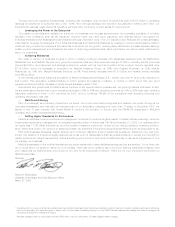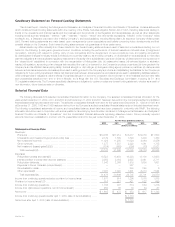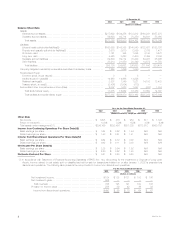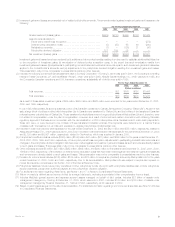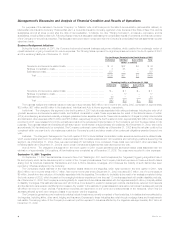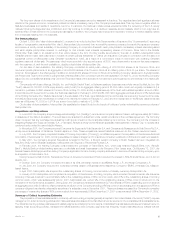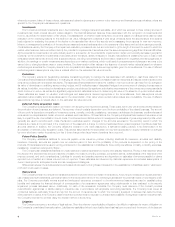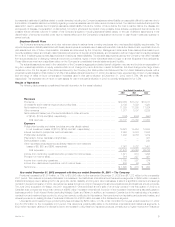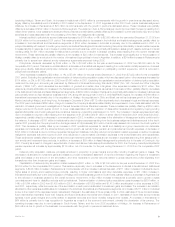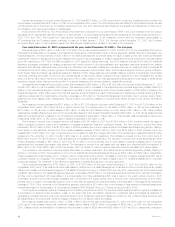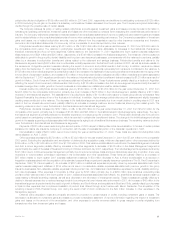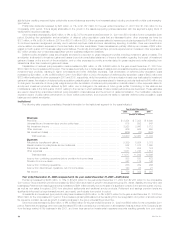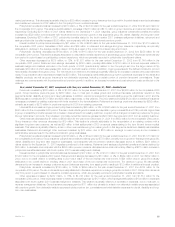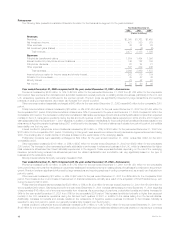MetLife 2002 Annual Report Download - page 10
Download and view the complete annual report
Please find page 10 of the 2002 MetLife annual report below. You can navigate through the pages in the report by either clicking on the pages listed below, or by using the keyword search tool below to find specific information within the annual report.inherently uncertain. Many of these policies, estimates and related judgments are common in the insurance and financial services industries; others are
specific to the Company’s businesses and operations.
Investments
The Company’s principal investments are in fixed maturities, mortgage loans and real estate, all of which are exposed to three primary sources of
investment risk: credit, interest rate and market valuation. The financial statement risks are those associated with the recognition of impairments and
income, as well as the determination of fair values. The assessment of whether impairments have occurred is based on management’s case-by-case
evaluation of the underlying reasons for the decline in fair value. Management considers a wide range of factors about the security issuer and uses its
best judgment in evaluating the cause of the decline in the estimated fair value of the security and in assessing the prospects for near-term recovery.
Inherent in management’s evaluation of the security are assumptions and estimates about the operations of the issuer and its future earnings potential.
Considerations used by the Company in the impairment evaluation process include, but are not limited to: (i) the length of time and the extent to which the
market value has been below amortized cost; (ii) the potential for impairments of securities when the issuer is experiencing significant financial difficulties;
(iii) the potential for impairments in an entire industry sector or sub-sector; (iv) the potential for impairments in certain economically depressed geographic
locations; (v) the potential for impairments of securities where the issuer, series of issuers or industry has suffered a catastrophic type of loss or has
exhausted natural resources; and (vi) other subjective factors, including concentrations and information obtained from regulators and rating agencies. In
addition, the earnings on certain investments are dependent upon market conditions, which could result in prepayments and changes in amounts to be
earned due to changing interest rates or equity markets. The determination of fair values in the absence of quoted market values is based on valuation
methodologies, securities the Company deems to be comparable and assumptions deemed appropriate given the circumstances. The use of different
methodologies and assumptions may have a material effect on the estimated fair value amounts.
Derivatives
The Company enters into freestanding derivative transactions primarily to manage the risk associated with variability in cash flows related to the
Company’s financial assets and liabilities or to changing fair values. The Company also purchases investment securities and issues certain insurance and
reinsurance policies with embedded derivatives. The associated financial statement risk is the volatility in net income which can result from (i) changes in
fair value of derivatives not qualifying as accounting hedges, and (ii) ineffectiveness of designated hedges in an environment of changing interest rates or
fair values. In addition, accounting for derivatives is complex, as evidenced by significant authoritative interpretations of the primary accounting standards
which continue to evolve, as well as the significant judgments and estimates involved in determining fair value in the absence of quoted market values.
These estimates are based on valuation methodologies and assumptions deemed appropriate in the circumstances. Such assumptions include
estimated market volatility and interest rates used in the determination of fair value where quoted market values are not available. The use of different
assumptions may have a material effect on the estimated fair value amounts.
Deferred Policy Acquisition Costs
The Company incurs significant costs in connection with acquiring new insurance business. These costs, which vary with and are primarily related to
the production of new business, are deferred. The recovery of such costs is dependent upon the future profitability of the related business. The amount
of future profit is dependent principally on investment returns, mortality, morbidity, persistency, expenses to administer the business, creditworthiness of
reinsurance counterparties and certain economic variables, such as inflation. Of these factors, the Company anticipates that investment returns are most
likely to impact the rate of amortization of such costs. The aforementioned factors enter into management’s estimates of gross margins and profits, which
generally are used to amortize such costs. Revisions to estimates result in changes to the amounts expensed in the reporting period in which the
revisions are made and could result in the impairment of the asset and a charge to income if estimated future gross margins and profits are less than
amounts deferred. In addition, the Company utilizes the reversion to the mean assumption, a standard industry practice, in its determination of the
amortization of deferred policy acquisition costs. This practice assumes that the expectation for long-term appreciation in equity markets is not changed
by minor short-term market fluctuations, but that it does change when large interim deviations have occurred.
Future Policy Benefits
The Company establishes liabilities for amounts payable under insurance policies, including traditional life insurance, annuities and disability
insurance. Generally, amounts are payable over an extended period of time and the profitability of the products is dependent on the pricing of the
products. Principal assumptions used in pricing policies and in the establishment of liabilities for future policy benefits are mortality, morbidity, expenses,
persistency, investment returns and inflation.
The Company also establishes liabilities for unpaid claims and claims expenses for property and casualty insurance. Pricing of this insurance takes
into account the expected frequency and severity of losses, the costs of providing coverage, competitive factors, characteristics of the insured and the
property covered, and profit considerations. Liabilities for property and casualty insurance are dependent on estimates of amounts payable for claims
reported but not settled and claims incurred but not reported. These estimates are influenced by historical experience and actuarial assumptions of
current developments, anticipated trends and risk management strategies.
Differences between the actual experience and assumptions used in pricing these policies and in the establishment of liabilities result in variances in
profit and could result in losses.
Reinsurance
The Company enters into reinsurance transactions as both a provider and a purchaser of reinsurance. Accounting for reinsurance requires extensive
use of assumptions and estimates, particularly related to the future performance of the underlying business and the potential impact of counterparty credit
risks. The Company periodically reviews actual and anticipated experience compared to the aforementioned assumptions used to establish policy
benefits and evaluates the financial strength of counterparties to its reinsurance agreements using criteria similar to that evaluated in the security
impairment process discussed above. Additionally, for each of its reinsurance contracts, the Company must determine if the contract provides
indemnification against loss or liability relating to insurance risk, in accordance with applicable accounting standards. The Company must review all
contractual features, particularly those that may limit the amount of insurance risk to which the Company is subject or features that delay the timely
reimbursement of claims. If the Company determines that a contract does not expose it to a reasonable possibility of a significant loss from insurance risk,
the Company records the contract using the deposit method of accounting.
Litigation
The Company is a party to a number of legal actions. Given the inherent unpredictability of litigation, it is difficult to estimate the impact of litigation on
the Company’s consolidated financial position. Liabilities are established when it is probable that a loss has been incurred and the amount of the loss can
MetLife, Inc.
6



